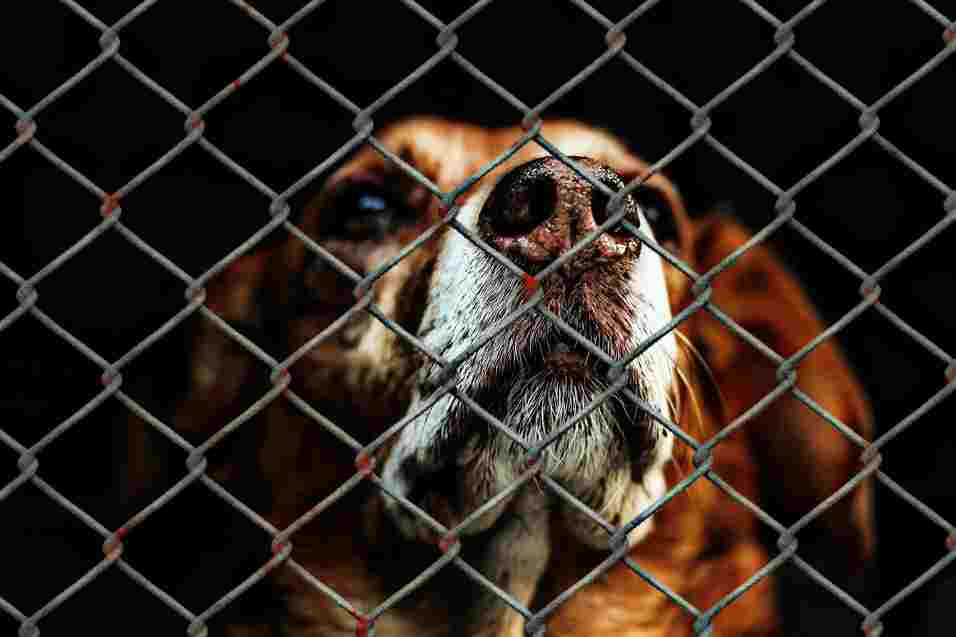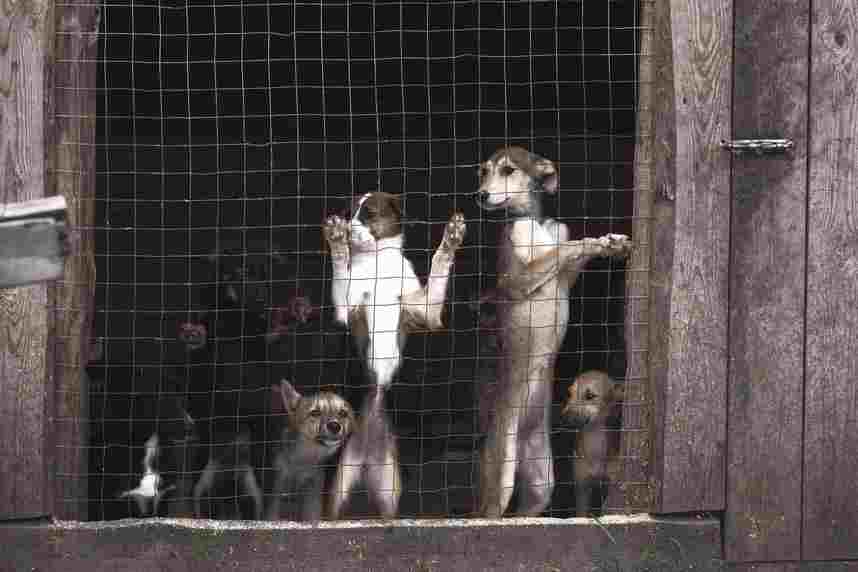Crate training a rescue dog has gotten a really bad reputation among dog owners. They sure are the hardest to train but not to the point that people are describing.
There are a few cases where crate training a rescue dog is hard painful and really long. But this is mainly due to previous experiences that the dog might have had in the past.
However, if you have a rescue dog that has not been abused in the past it will be just a matter of adjusting to a new environment and then it’s a regular dog training.
Rescue dogs often take more time to crate train but not always every dog is different.
So how can you make a rescue dog comfortable enough to speed up the training and get through any trouble you may encounter?
You simply need a plan with clear steps to follow and consistency in training.
How do you crate train a rescue dog?
To crate train your rescue dog successfully with no potential issues; all you have to do is follow these 5 easy tested steps to success.
Every one of these steps is as important as the next and the order in which you do them is also important.
1. Know your dog
The first thing I personally do and would strongly recommend that you do as well when bringing a rescue dog home; is to gather as much information about the dog as possible.
Sometimes you can get very useful insights about the dog’s previous experiences from the dog shelter. Most shelters do a great job on this point so don’t hesitate to ask around.
Knowing what your new best friend has been through could be very helpful in helping him adjust to his new home.
Sadly, some dogs get abused by previous owners and develop some anxieties and trust issues. Knowing what exactly are those could help you overcome these fears and trust issues.
Knowing your dog is also observing his reactions to different situations; a new puppy is a new page you can just teach new things and it would be easy; An older dog especially a rescue one has some old habits maybe fears that you have to change before he can acquire new ones.
You need to know how your new rescue dog feels about confine places. So, you have to carefully test his reactions. You don’t want your dog to have a bad reaction to the crate. So, we do test it on some confined space in the house before we start.
You also want to observe his sleeping habits and if he gets enough sleep during the night. This way you know what to expect during the night.
All these observations have one and only purpose; to avoid any incidents that may be related to the crate. The crate should have only great experiences associated with it to successfully crate train your rescue dog.
2. Choosing the right crate
Now, this is a tip that you will read in every crate training guide on the article. Why? because if you don’t get it right your chances of getting your dog to like the crate are slim.
The right crate is a vague concept that could have many interpretations like the size perhaps the material used to build it or perhaps sturdiness…
Actually, it is a mix of all the requirements that would make a dog feel safe intimate and comfortable in his crate.
The first thing you need to look for in the crate is the size which is the most important point. And it’s not as easy as let us get the largest crate we can find. The size of the crate needs to be perfect.
It should allow the dog to stand without touching the top of it to turn around comfortably and to lay down easily.
If you pick a crate that is too big for the dog he will most likely use one corner for sleeping and chilling (so it will be a den within the den) and the other as a potty corner.
The crate needs to be a perfect size and you need to measure your dog for his crate. I suggest you read this useful guide about how to measure your dog for a crate and how to choose the perfect one.
For a rescue dog, I would strongly recommend opting for a wire crate. It provides many features that help tremendously with the first few stages of crate training. The crate I recommend has two doors(Click to check the current price on Amazon). The wire crate offers much more open space especially with the two doors which makes it easier to lure the dog into it.
3. Preparing training treats and toys
By now you should have made a good idea about how your dog is and already prepared a nice crate for him. But you still need two more things before you start crate training, and they are equally important to the crate.
You need some good training treats and some toys, and these are your way to lure the dog to the crate and reward him when he does something you like.
Training treats
You have to be careful though when choosing training treats, you need something healthy natural and safe. I would suggest the Bil-Jac VetDogs treats(click to check the current price on Amazon). They are a safe brand made in the USA and they support a great cause providing service dogs to veterans with disabilities.
Using treats for crate training is very useful and allows you to make great progress really fast. However, you can’t just give your dog treats without taking into consideration his daily caloric intake.
A dog that is given too many treats could get dog obesity that leads to many dangerous health issues. and if you give treats at the expense of regular food your dog will not have sufficient nutrition.
I suggest you read this article that will help you calculate the number of treats you can give your dog per day. But also how to phase out on treats when your dog is making progress.
Training toys
Training toys are also a great motivational tool to get your dog used to be in the crate. They also do a great job keeping the dog distracted while you are not around and finally they are your way to phase out on training treats.
There are four categories of dog toys and each one has a specific role in training and teaching the dog behavior you like. Unfortunately, toys are very misused by most dog owners and very few do make the difference and how to use each one.
For more information about the different types of toys how to choose the ones you need and how to use them check out this article.
The toy that is mostly used in the crate is the chew toy, we strongly recommend the Kong(Click to check the current price on Amazon). This one is simply the best ou there. the possibility to fill it with treats or regular food is very helpful in minimizing boredom when the dog is alone.
You can use it for outdoor activities by securing it to a tree and letting your dog enjoy the sun. the kong is really the best toy for crate training a rescue dog.
4. Introducing the dog to his crate
Now that you are all set you can move one to actually introducing your dog to his crate. This part is better than in the morning before it’s time to actually sleep in the crate.
I can’t repeat this enough but never introduce your dog to something new when it’s time to do it. Your dog needs time to explore his crate feel safe around it and in it. If you just put him in it and lock it for the night you are creating a bad experience that will prevent you from making your dog like the crate.
Start by just walking around the crate and let the dog sniff around and explore freely. Don’t rush into it give it time and let him feel safe around it.
You want to secure the doors of the crate to avoid any sudden incidents that may freak him out. Then you can move on to something else away from the crate not to raise suspicion and go back again after a while.
Toss a treat in the crate to lure the dog in and once inside reward him with treats and verbal praise. Only give treats when the dog is inside and repeat the process a few times.
Then move away from the crate for a while and go back and keep using the treats until he offers to get in for the treats. This could take a while but if you keep doing it you will see progress.
Dogs are very intelligent animals and they love a good treat so he will eventually offer to get in on his own to get the treat. And that is your sign that the introductions are over and you can move on to the next step.
5. Making the crate great
Now that your dog is getting in the crate without any incidents and enjoying the treats. You can start building a happy relationship with the crate.
After all, the core idea of crate training is to make the dog love his crate. And to achieve that there are plenty of ways.
You can start by using food and feeding your dog his meals in the crate. Dogs love their food and it is actually one of the strongest motivators. You can read this interesting article about Pavlov behavioral experiences on dogs.
Associating food to the crate makes it instantly a great place to be; If your dog is having his meals in the crate and every time he gets there some nice treats suddenly appear; why wouldn’t he like it!
You can build upon that by using chewy toys preferably the kong. Use it first outside of the crate to hook him up on it. Then remove it and only give it back inside the crate. Every time he takes it and goes out you want to take it back inside.
Crate training a rescue dog is easy when done right and with the right tools. Your dog needs to have a great time in his crate. So in the first few days give him some attention in there and have some nice playtime in it.
You need your dog to be low on energy when he is in the crate; so use interactive toys to reduce his energy and go for outdoor activities before getting in the crate.
Once your dog is comfortable chewing on his toy inside the crate; you can fill the kong with treats and attach it to the crate and let him enjoy it with the door closed.
6. Making a crate training schedule
What you need to crate train a rescue dog is consistency; The best way you can obtain that by making a crate training schedule.
A crate training schedule allows you to organize your dog’s day according to yours. It also allows the dog to expect what to come and to be excited about it.
Making a crate training schedule for a rescue dog is easier than it is for puppies. Older dogs have better control over their bladder and sleep, less and can stand long hours in the crate.
You need your dog to have his meals at the same time every day; to go to bed at the same time and to have his activities also at the same time. This allows your rescue dog to feel stability and to adjust faster to a new home.
It may sound complicated to keep a schedule for your dog, but all you have to do is to make his according to yours. Even if you work a full-time job you can have a crate training schedule for your rescue dog.
If you need some help making a crate training schedule for your dog; read this article which has some case studies and examples you can use.
Following a program helps obtain consistency in training which helps a lot speeding the process.
If you follow these easy 6 steps your rescue dog will be comfortable in his crate in no time.
Crate training an older rescue dog

Older rescue dogs are not the easiest to crate train, but once trained they can spend long hours in the crate which is useful if you are working full-time.
What makes older dogs harder to train is that they are used to a certain behavior and ways that you have to deal with before successfully acquiring new ones.
Older rescue dogs are more resistant to change and therefore to crate training than younger puppies. They sure had more experiences that could be difficult to get passed.
Nonetheless, patience and consistency in training can help you surpass these difficulties. You just need to take things slower and let the dog build a trust relationship with his new home.
The worst thing you can do when crate training an older rescue dog is to rush him into the crate before he is ready.
The crate training steps are basically the same; you just have to take more time with each one to make sure there is no resistance.
outdoor activities are also a great way to bond and reduce energy which is very helpful when crate training.
Older dogs can tolerate long hours in the crate but that does not mean you can just from the start lock your dog for the day. You have to gradually increase the time your dog spends in the crate. If you can break those crating sessions it would be even better.
If the dog is too old you should consider less training according to the dog’s overall health. Activities do help but the older the dog gets the less he needs and the lower he is on energy. So, make sure you take that into consideration before you program your play sessions and exercising activities.
How to crate train a rescue dog who hates the crate
We spoke earlier about knowing your dog and how it could help you crate train your rescue dog without incidents. Crate training a rescue dog that hates crates is really hard and time-consuming; it requires a lot of patience but it’s not impossible and knowledge is key.
When you know your dog hates crates before actually introducing him to one; you can avoid the chock and the freaking out.
Dogs don’t hate for fun, they often hate things that they’ve had bad experiences with. So basically all you have to do is to replace those with some happy ones.
It is easier said than done that I will admit but with the time you can do it. Your best option is to start with a crate that has a lot of open space.
The wire crate is your best option so just place it somewhere in the house where the dog can see it but not too close. It would be better if it is close to an area where you play with him.
Slowly while playing with toys and treats start luring the dog towards it. If you are patient enough and do this correctly the dog will start learning that the crate is not bad and can’t hurt him. He needs to have some good times while the crate is in his sight.
Once the dog is comfortable playing around the crate you can start tossing some treats in it and maybe a toy getting closer and closer until he gets in. Then you can start the crate training steps normally but don’t rush the dog in it give him time to feel safe around it.
Where to put a rescue dog crate in the house
Choosing the right spot for the crate is key to crat training your rescue dog. They particularly need extra attention to feel safe and adjust to their new home. So where should you put a rescue do crate in your house?
When you’ve just started crate training your rescue dog the best spot is in your room at night. The dog needs to feel your presence and you can be close if he starts whining.
You need to hear your dog if he wakes up and starts whining so you can deal with it and reassure him.
During the day you want to choose a spot that is close to the family living area but still intimate for the dog. You also want to make sure he is getting enough air and not in a hot area.
Avoid placing the crate close to refrigerators and other machines and generators that make loud sounds. It could make the dog uncomfortable and crate training harder.
You can change spots during the day according to your activity around the house. And choose an open area if you are leaving the dog alone in the crate.
When your dog is used to his crate you can place it somewhere else during the night. But always avoid dark and cold places and also spots where there is to much noise or external distractions.
If you don’t have much choice and have limited space you can use a crate cover like this one
How long does it take a rescue dog to adjust?
Rescue dogs are very unpredictable, and very different one from another. How long it is going to take for a rescue dog to adjust can vary according to every dog’s own experiences.
Usually, dogs with trust and fear issues are the ones that take too long to adapt to new environments.
Stability can help a lot in making the rescue dog feel safe. This is why crate training a rescue dog is a great idea. The crate provides the safety of a den that the dog needs to boost his confidence.
Making a crate training schedule is also a great idea that helps the dog settle down and have his own daily routine. Having a routine makes us feel stability and so it does for dogs.
How long it is going to for your rescue dog to adjust entirely depends on you and what you do to help him achieve that. But little things like the age and breed of the dog and how was he treated before can make a great difference.
Having other pets around the house could determine how fast your dog is going to get along with them and find his own place in the house.
All in all, it’s up to you to make the rescue dog feel at home; but how exactly can you help your dog adjust.
How can I help my rescue dog adjust to a new home?
The best thing you can do to help your rescue dog adjust to his new home is crate training and making a daily routine.
These two are the fastest way to make a dog feel comfortable safe and stable.
There are also physical activities and playtime, especially with interactive toys. Play sessions help you bond with your dog and break the ice.
Avoid yelling and any aggressive behavior around your dog. Dogs are very sensitive animals and they can easily pick up your vibes.
Also never punish your rescue dog or reprimand him especially in the early days. Punishing a dog is never a good idea in fact if you don’t catch your dog in the act punishment will only confuse him.
Take your dog out for walks so he can feel the safety of his new home and be excited to be back in it.
A lot of physical contact and rubbing; bonding with your dog will help him the most adjust. But how can you bond with a rescue dog that may have trust issues?
How do I bond with my rescue dog?

Bonding with any dog is based on quality time and activities. Bonding with a rescue dog will take much more time.
You need from the start to dedicate a lot of quality time to your new dog. Play with some interactive toys and use a lot of verbal praise. Treats could also be great if used with moderation.
You want to have a lot of touchy gaming and rubs. Also verbal praise and a lot of it. Outdoor activities are also great for bonding.
Training, in general, is good for having the dog used to you and getting to know what you like and don’t like.
Crate training also allows the dog to have the safety of his den and feel comfortable in his new home.
Include your dog in your daily activities, dogs are great and will enjoy there time with you as long as you include them. So even watching TV could turn into quality time if your dog joins you on the couch and you give him a nice rub.
Sometimes the best bonding tip is actually not doing something wrong. So, avoid all kinds of aggressive behavior around your dog. dogs pick up easily on your vibes so be careful how you react around them.






